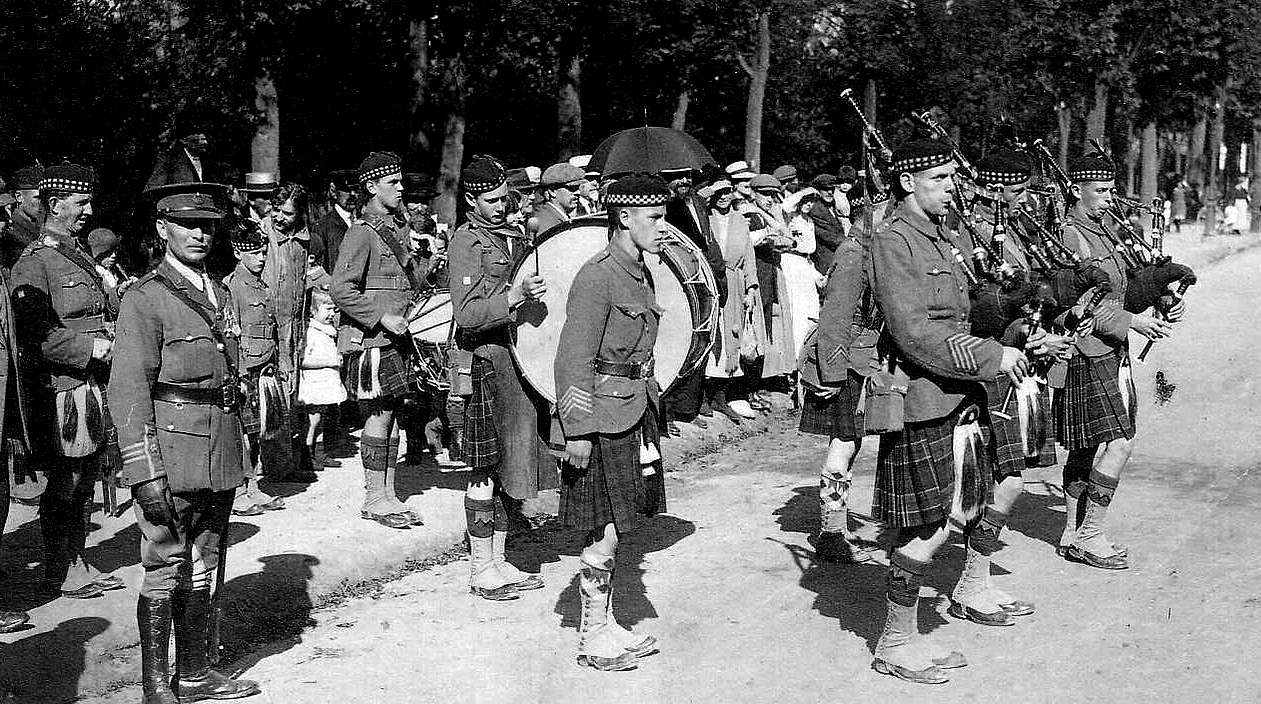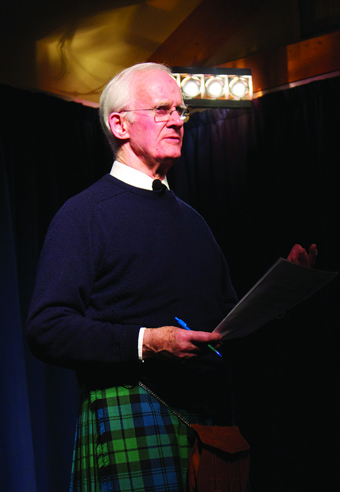Memorable Tunes from the Bloody Fields of Flanders
 Author Colin Campbell gives his background to some of the pipe tunes associated with the First World War and describes tunes played by Stuart Liddell, Inveraray, and grandson of P/M Ronald MacCallum of the 8th Argyll & Sutherland Highlanders, at the concert held earlier this year courtesy the Scottish Pipers’ Association:
Author Colin Campbell gives his background to some of the pipe tunes associated with the First World War and describes tunes played by Stuart Liddell, Inveraray, and grandson of P/M Ronald MacCallum of the 8th Argyll & Sutherland Highlanders, at the concert held earlier this year courtesy the Scottish Pipers’ Association:
2/4 Marches: Kemmel Hill – the 93rd/2nd A&SH held Kemmel Hill during a German offensive in 1918 to break the Allies after the Russians had ceased to be a menace and the US troops were not in France in great numbers. George Ross’s Farewell to Black Watch – Ross served in the Black Watch for over 24 years and in the Argyll Volunteers and 8th as P/M from c. 1900 – 1914
P/M William Lawrie 6/8 marches: Captain Duncan McCrae of Ballimore was an Argyll man, son of the renovator of Eilean Donan Castle, who served with the Seaforths in India and then with the Royal Flying Corps. Taken prisoner by the Turks. Lt John Crawford Buchan V.C. was wounded on 21 March 1918 east of Marteville, west of Saint Quentin, Picardy, France, and died the following day. His citation reads: ‘For most conspicuous bravery and devotion to duty. When fighting with his platoon in the forward position of the battle zone, 2nd Lt. Buchan, although wounded early in the day, insisted on remaining with his men, and continually visited all his posts, encouraging and cheering his men in spite of most severe shell fire, from which his platoon was suffering heavy casualties. Later, when the enemy were creeping closer, and heavy machine-gun fire was raking his position, 2nd Lt. Buchan, with utter disregard of his personal safety, continued to visit his posts, and though still further injured accidentally, he continued to encourage his men and visit his posts. Eventually, when he saw the enemy had practically surrounded his command, he collected his platoon and prepared to fight his way back to the supporting line. At this point the enemy, who had crept round his right flank, rushed towards him, shouting out ‘Surrender’. ‘To hell with surrender,’ he replied, and shooting the foremost of the enemy, he finally repelled this advance with his platoon. He then fought his way to the supporting line of the forward position, where he held out till dusk. At dusk he fell back as ordered, but in spite of his injuries again refused to go to the aid post, saying his place was beside his men. Owing to unexpected withdrawal of troops on the left flank it was impossible to send orders to 2nd Lt. Buchan to withdraw, as he was already cut off, and he was last seen holding out against overwhelming odds. The gallantry, self-sacrifice, and utter disregard of personal safety displayed by this officer during these two days of most severe fighting is in keeping with the highest traditions of the British Army. —The London Gazette, 21 May 1918 the last of three brothers to be killed. He was buried at Roisel Communal Cemetery Extension, Roisel, Somme, France

P/M John McLellan – Longueval: On 14th July 1916 the 10th Argylls 9th (Scottish) Division attacked at 3.50am led by pipers James Dall and D. Wilson and P/M Aitken who was aged 60 and subsequently won the Distinguished Conduct medal. This report from the ‘History of 9th Scottish Division’ reads ‘The Argylls met with complete success. The leading companies kept close to the barrage, leaving the supporting companies to clear the enemy’s front trenches. The 11th Royal Scots on the left being delayed by uncut wire, C Company of the Argylls in left support, came to their assistance by bombing to the north. This company killed at least 100 of the foe, and drove others along the front of the 27th Brigade. In this lively action a machine-gun was captured, a well-aimed bomb accounting for the whole team. The other companies of the Argylls in their impetuous eagerness ran into our barrage and suffered some casualties. Then, until the barrage lifted, the men lay down in shell holes, while a piper played the regimental march. The advance was resumed ……..and the battalion commenced to consolidate.’ There is a Pipers’ Memorial at Longueval, plus a South African Memorial. The South African Brigade was in 9th (Scottish) Division from April 1916 till September 1918.
Men of Argyll, 8th Argylls at Bazincourt/ 8th Argylls Farewell to the 116eme Regiment of the Line – composer John MacLellan was P/M of the 8th Argylls 1930-35. In 1915 the 51st (Highland) Division came south from Flanders to release French troops for the Battle of Verdun. The troops were Bretons, with whom the Highlanders had a shared Celtic heritage. They got on well. The officers enjoyed the high quality wine in the French messes, and the men probably shared pinard, a rough red wine, the French soldier’s daily ration of which was a litre. When the French marched away some of the 51st’s bands led them for a distance. The French/Breton troops of 116eme regiment were from Vannes. Bouzincourt is just NW of the town of Albert in Picardy.
Dugald MacColl’s Farewell to France by John MacColl commemorates his son Dugald’s safe return from France, having served in the Royal Army Medical Corps
The Unknown Warrior by P/M John MacLellan: 26.4% of the Scots who marched away did not come home: the percentage for the rest of the UK and Ireland was 11.8% and for France 16.8%. 1.6% of the adult male population of the UK and Ireland died in the war. Scotland’s adult male population was depleted by 3.1%. Only the Serbs and Turks had a higher proportion of participant deaths than Scotland. The government decided that no bodies would come home, and that all would have identical gravestones. However, almost half the dead were unidentified or missing, and many of these never found. An Army Chaplain, the Rev. David Railton, had the idea of the tomb of the Unknown Warrior and this was consecrated at Westminster, London, on 11 November 1920.
Battle of the Somme by P/M William Lawrie. In this battle the UK and British Empire suffered 420,000 wounded and 95,000 dead, France 200,000 wounded and 50,000 dead and Germany 465,000 wounded and 164,000 dead. The Allies advanced six miles on a 16 mile front. They lost it all to the German March Offensive in 1918, but recovered it before the end of the war.
*The next concert in this series will be held at the College of Piping in December. Here’s how the BBC first announced the funding award to the Scottish Pipers’ Association:
‘Lost’ WW1 bagpipe tunes researched
Several of today’s best known bagpipe tunes, such as Battle of the Somme and The Bloody Fields of Flanders, were written in the trenches.
But many more pieces are thought to have been forgotten once the war ended.
Of the 2,500 pipers involved in the Great War, some 500 were said to have been killed and a further 600 wounded.
The losses were so great in the early stages of the war that the tradition of them leading Scottish regiments into battle was reputedly banned by the War Office.
But the practice continued regardless, and the skirl of the pipes echoed across battlefields throughout the conflict.




















Where can one find this tune? Can you please send me a copy of it? I need it for a piper history project.
P/M William Lawrie 6/8 marches: Captain Duncan McCrae of Ballimore was an Argyll man, son of the renovator of Eilean Donan Castle, who served with the Seaforths in India and then with the Royal Flying Corps. Taken prisoner by the Turks.
While not specific to Flanders Field, my favorite finger twisting 2/4 is “Ladies From Hell”. For such an awesome Chune, with the coolest name.. it boggles my mind that it is way underplayed, and unknown. I guess since it only has 3 parts, nobody is out there trying to put Judges to sleep with it, and thats why so many have never heard of it??
And it has to be said, “8th Argylls Farewell to the 116eme Regiment of the Line” was composed by William Lawrie, who was P/M of the 8th A&SH there.
“The Unknown Warrior” was composed by George S. MacLennan, P/M 1st Bln the Gordon Highlanders. John was his brother, and a good piper, but nothing like GS.
Very nice information but you’ve forgotten the Piper’s Mémorial of Longueval (Somme) which has been unveiled in 2002 .